Are Bees the Only Pollinators?
Hi! Welcome back to the Kids Answers magazine blog, where we answer your big questions about God’s Word and God’s world.
In the April–June 2023 issue of Kids Answers magazine, we learned about superhero honeybees. Honeybees are pollinators, which means they fertilize flowers to help plants grow. Flowers make and store nectar—a sticky sweet liquid—inside them. Nectar gives bees the energy they need for flight, and nectar is what bees use to make the delicious treat we enjoy—honey!

Photo by József Szabó on Unsplash
Flowers also produce pollen, a dusty yellow powder. When a bee stops on a flower for a drink of nectar, its fuzzy body gets coated with pollen. The pollen rubs off on the next flower the bee visits, fertilizing the flower and causing new flowers to grow.
Most people already know about pollinating bees, but God’s creation is filled with other superhero pollinators of every shape and size, living in nearly every place on earth.
In the Air
Insects like bees, flies, moths, wasps, beetles, and butterflies pollinate most of our world’s plants. Some birds are pollinators, too, including hummingbirds. Bats are another type of flying pollinator.
Perdita minima, known as “the world’s smallest bee,” is one of the tiniest pollinators that we know about. This itty-bitty bee is less than two millimeters long—about as wide as the tip of a crayon!
On the Ground
Some nonflying creatures such as monkeys, lemurs, possums, rodents, and lizards are also pollinators. As they visit each flower for a nectar treat, pollen sticks to their fur or skin and rubs off on the next plant.
The world’s largest known pollinator is the black-and-white ruffed lemur of eastern Madagascar. They collect nectar from a large plant called the traveler’s palm. Fully grown, the lemurs can be almost two feet (.6 meter) long and weigh up to 10 pounds (4.5 kilograms).

Black-and-white Ruffed Lemur (Varecia variegata).
Observation by fishhead, CC0 1.0, via iNaturalist.
Under the Sea
Researchers have discovered a type of pollinator exists underwater! The Baltic isopod (a sea creature without a backbone) pollinates red seaweed growing on the floor of tide pools.
Do you have a question about God’s Word or his world that you want us to answer? Is there a topic you want to learn more about? Ask your parents to help you submit your question today. We’d love to hear from you!
- © 2024 Answers in Genesis
- Privacy Policy
- Contact
- About
